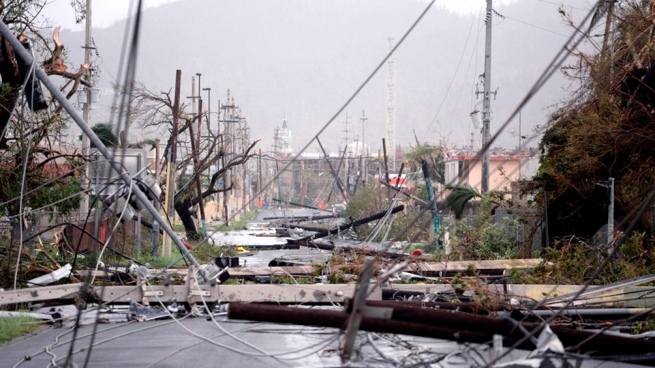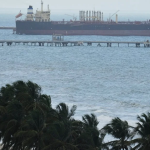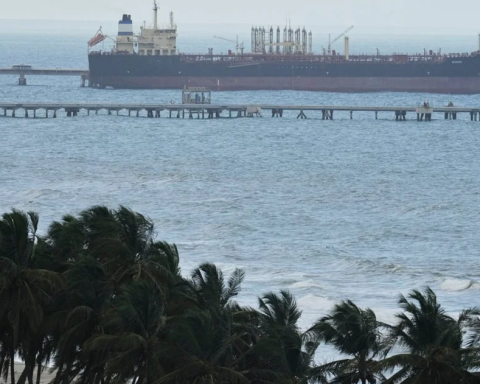Hurricane Fiona made landfall this Sunday in southern Puerto Rico and caused a general blackout and overflow of rivers, two days before the fifth anniversary of the arrival of Hurricane Maria, which devastated the island and left almost 3,000 dead.
Fiona, which has already plunged all of this US territory into darkness, made landfall near Punta Tocón (southwest), reported the US National Hurricane Center (NHC).
The storm is located about 15 km west of Mayaguez, on the western coast of Puerto Rico, and is moving with winds of up to 140 km/h towards the Dominican Republic.according to the latest NHC bulletin, reported the AFP agency.
At the moment it is category 1, the lowest of the five on the Saffir-Simpson scale, but it is expected to “strengthen further in the next 48 hours,” the NHC said.
The Dominican Republic, which expects to be impacted by the phenomenon in the early hours of Monday, suspended the working day this Monday and declared 13 of its 32 provinces on red alert.located in the north and east of the country.
The storm has caused a general blackout on the island since shortly after 1:00 p.m. (2:00 p.m. Argentine time), reported the Puerto Rico Electric Power Authority, the public corporation in charge of electricity generation.
That entity has already managed to restart several generators, a first step towards reestablishing the electrical network, said its director, Josué Colón, in a television interview.
#Puerto Rico ??| Moment in which the bridge collapses in Utuado, Puerto Rico, after the passage of #HurricaneFiona. pic.twitter.com/cObJZIMQSz
– Miguel Vaquerano ?? (@MigueVaquerano) September 18, 2022
According to established protocols, once that network is reactivated, the authority will first try to restore service to hospitals and other government buildings that offer essential services.
“The entire island is experiencing a great accumulation of water,” said the governor of Puerto Rico in the afternoonPedro Pierluisi, at a press conference.
The authorities reported serious damage in many towns in Puerto Rico, such as falling trees and power lines, landslides, landslides, obstructions on the roads.
In Utuado, a town in the center of the island, the flooding of a river swept away a bridge, according to Pierluisi.
“The damage we are seeing is catastrophic in several areas.”declared the governor.
The Grande de Loiza River and the Cagüitas River, in the north and center of the island, overflowed in some areas, the United States National Weather Service (NWS) reported on Twitter.
According to local media, other rivers overflowed their banks in the southeast of the island, flooding roads and urban areas, and in the mountains and the southwest, several families lost the roof of their houses due to gusts of wind and had to take shelter. in government-approved shelters.
The hurricane left about 196,000 people without drinking waterdue to blackouts and flooding of the rivers, the authorities indicated.
?Fiona in PR!?
This is the scenario that exists in various locations in Puerto Rico after Hurricane Fiona passed through the island.
According to the authorities, some cities have been cut off.#TheNewDiarioRD #Fiona #Hurricane #Puerto Rico pic.twitter.com/9isxLr93Ib
– The New Diary (@elnuevodiariord) September 18, 2022
Pierluisi announced the suspension of classes in schools on Monday, due to forecasts that the rains will continue.
It also canceled the work of government employees, except those who occupy critical positions or provide essential services during the emergency.
US President Joe Biden approved the declaration of a state of emergency in Puerto Rico, a measure that allows federal funds to be released for relief efforts.
“Conditions are going to be very favorable for these downpours to continue rising from the Caribbean Sea to historic levels, to catastrophic levels,” said Ernesto Morales, of the NWS, at the same press conference as the governor.
Authorities expect 30 inches (762 mm) of rain in two days, as heavy rain is also expected on Monday, Morales said.
During Hurricane Maria, which hit the Caribbean territory almost five years ago, 40 inches of rain (1,244 mm) were reached.
As a result of Maria, Puerto Rico was cut off and large areas were without electricity for months. Almost 3,000 people died as a result of the disaster, according to the official balance.
Fiona already caused serious damage as it passed through Guadeloupe on Friday night, where, in some places, the water rose to more than 1.50 meters in that French territory. A man died there, washed away with his house by a rising river.
The warming of the ocean surface increases the frequency of the most virulent hurricanes, with stronger winds and more intense rains, according to experts, AFP concluded.


















